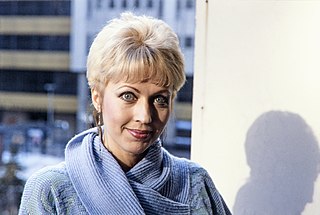
The Eurovision Song Contest 1973 was the 18th edition of the annual Eurovision Song Contest.

Finland has participated in the Eurovision Song Contest 53 times since its debut in 1961. Finland won the contest for the first – and to date only – time in 2006 with Lordi's "Hard Rock Hallelujah". The country's best result before then was achieved by Marion Rung with the song "Tom Tom Tom" in 1973, which placed sixth.

"A Million in One, Two, Three" was the Belgian entry in the Eurovision Song Contest 1977, performed in English by Dream Express, a band consisting of Luc Smets and the three Maessen sisters: Bianca, Patricia and Stella. In 1970 the Maessen sisters had represented their native Netherlands with "Waterman", then under the group moniker Hearts of Soul.

"To Katalava Arga" was the Cypriot entry in the Eurovision Song Contest 1985, both written and performed in Greek by Lia Vissi.

"Tipi-tii" was the Finnish entry in the Eurovision Song Contest 1962, performed in Finnish by Marion Rung, and composed by Kari Tuomisaari, who also wrote the lyrics. The song is the first hit in Marion Rung's long career.

Muistathan" was the Finnish entry in the Eurovision Song Contest 1972, performed in Finnish by Päivi Paunu & Kim Floor.

"Tom Tom Tom" was the Finnish entry in the Eurovision Song Contest 1973, performed in English by Marion Rung. This was Rung's second Eurovision entry: in 1962 she had made her debut in the Contest as a 16-year-old with "Tipi-tii", which finished in 7th position.

"Pump-Pump" was the Finnish entry in the Eurovision Song Contest 1976, performed in English by Fredi & Ystävät. This was Fredi's second Eurovision entry, he had made his debut in Vienna, Austria in 1967 with "Varjoon – suojaan", placing 12th in a field of 17.

"Huilumies" was the Finnish entry in the Eurovision Song Contest 1980, performed in Finnish by Vesa-Matti Loiri. The song was composed by Aarno Raninen, who also had composed 1977 entry "Lapponia". In turn, lyricist Veikko 'Vexi' Salmi had also written the lyrics to 1979 entry "Katson sineen taivaan".

"Nuku pommiin" was the Finnish entry in the Eurovision Song Contest 1982, performed in Finnish by Kojo.

"Fantasiaa" (Fantasy) was the Finnish entry in the Eurovision Song Contest 1983, performed in Finnish by Ami Aspelund. In 1977, Aspelund's sister Monica had represented Finland in the Contest with the song "Lapponia".

"Addicted to You" was the Finnish entry in the Eurovision Song Contest 2002, performed in English by Laura Voutilainen who was billed in the contest as "Laura".

"Libera" was the Italian entry in the Eurovision Song Contest 1977, performed in Italian by Mia Martini, at the time arguably Italy's most successful and celebrated female artist, having had a number of hits like "Padre davvero...", "Gesù è mio fratello", "Credo", "Piccolo uomo", "Donna sola", "Minuetto", "Il guerriero", "Inno", "Al mondo", "Donna con te", "L'amore è il mio orizzonte", "Che vuoi che sia... se t'ho aspettato tanto" on the Italian Hit Parade between the years 1971 and 1976, as well as taking part in the Sanremo Music Festival and Festivalbar on several occasions.
Aarno Raninen was a Finnish singer, songwriter and musician. His main instrument was piano but he has also mastered violin, cello and accordion.

Monica Aspelund is a Finnish singer. She is the older sister of Ami Aspelund.

Ami Aspelund is a Finnish singer. She is the younger sister of singer Monica Aspelund.
Finland was represented by Marion Rung, with the song '"Tipi-tii", at the 1962 Eurovision Song Contest, which took place on 18 March in Luxembourg City. "Tipi-tii" was chosen as the Finnish entry at the national final organised by broadcaster Yle and held on 15 February. Rung would represent Finland again in the 1973 contest, also held in Luxembourg.
Finland was represented by Laila Halme, with the song '"Muistojeni laulu", at the 1963 Eurovision Song Contest, which took place on 23 March in London. "Muistojeni laulu" was chosen as the Finnish entry at the national final organised by broadcaster Yle and held on 14 February. Halme originally finished third in the national final, but replaced the winning singer Irmeli Mäkelä at Eurovision for unknown reasons.
Finland was represented by the band Boulevard, with the song '"Nauravat silmät muistetaan", at the 1988 Eurovision Song Contest, which took place on 30 April in Dublin.
Finland was represented by Ami Aspelund, with the song '"Fantasiaa", at the 1983 Eurovision Song Contest, which took place on 23 April in Munich. "Fantasiaa" was chosen as the Finnish entry at the national final organised by broadcaster Yle and held on 28 January.















